The Meizu MX4 Pro Review
by Andrei Frumusanu on February 16, 2015 2:00 AM EST- Posted in
- Smartphones
- Exynos
- Mobile
- Meizu
Display Measurement
The Meizu MX4 Pro comes with a 5.46" JDI manufactured LCD. What differs from most other LCD panels that we've seen in mobile devices is that Meizu employs a much more precise backlight LED driver IC that is able to provide 2048 levels of brightness. Although this doesn't really affect everyday usage and such brightness resolution is not needed, it's the way that Meizu decides to use this in the lower brightness levels that really marks a departure from any other vendor.
Before getting into details of the low brightness performance, we'll look at the maximum luminance the display is able to achieve. As always, our display testing is done with an X-Rite i1Pro 2 as our measurement hardware, in conjunction with SpectraCal's CalMAN software suite and our own workflow to be able to get an accurate display characterization.
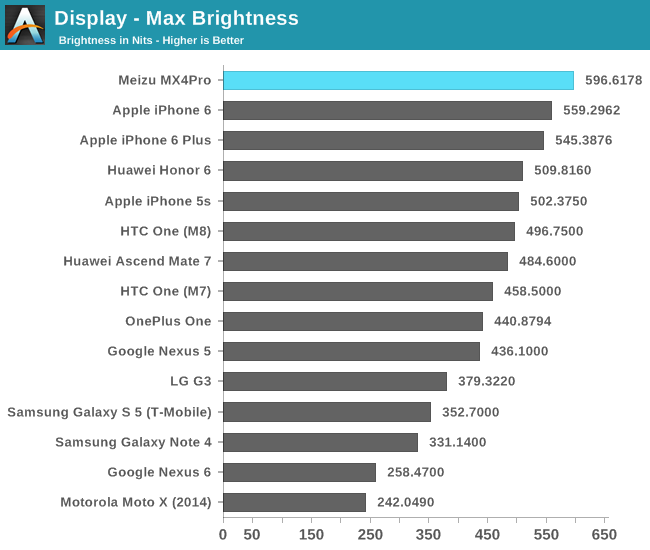
The Meizu MX4 Pro manages to dominate the brightness chart at 596 cd/m². This is easily one of the brightest devices we've tested, outperforming even Apple's iPhones. People who paid attention to Meizu's marketing materials will notice that they only proclaim a maximum brightness of 450 cd/m², and indeed my initial measurement when I received this review unit came in at a lower 484 cd/m². The increased brightness came only after I had updated the device to the 4.1l firmware, which unlocked the brightness slider to the maximum hardware brightness settings.

The black levels at maximum brightness remain quite high, providing one of the weakest performances among competing devices. Fortunately this happens only at maximum brightness as lower brightness settings such as at 200 cd/m² will achieve 0.1543 nits on black.
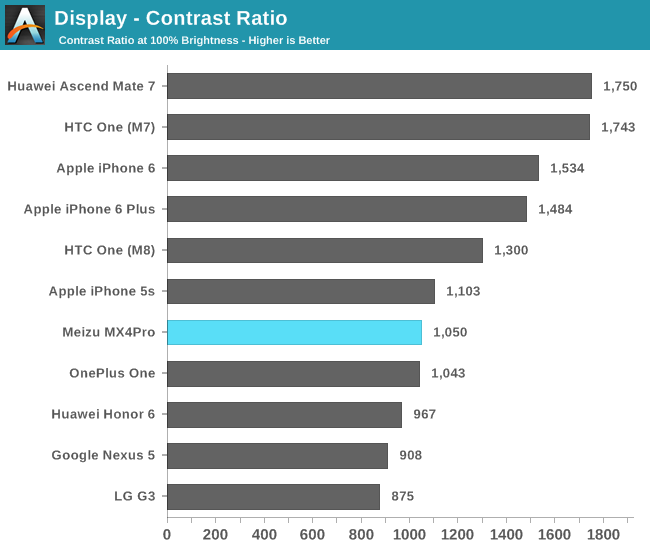
Due to the high black luminance at 100% brightness the Meizu achieves only a 1050:1 contrast ratio. Again, this only happens at maximum brightness as more normal use-cases such as our 200 nit measurement level will achieve a 1300:1 contrast ratio.
I've mentioned in the introduction that the screen is able to achieve excellent low-light brightness conditions, but nothing really prepared me for what I discovered. The MX4 Pro is able to achieve 2.7 cd/m² under the manual minimum brightness setting that is exposed via the brightness slider. This puts the Meizu at similar excellent low-light emission levels as Samsung's recent AMOLED devices such as the Galaxy S5 and the Note 4. Not only was this LCD screen able to match those the low brightness of Samsung's devices, but it managed to do it while retaining color accuracy and especially color resolution as dark grays would not suffer from the same black clipping that the recent AMOLED devices are displaying.
I specified that the 2.7 nits on the MX4 Pro was achieved with the minimum brightness slider because the actual hardware is capable of much lower settings. One might remember that Meizu markets the 2048 brightness levels of the display, however the lower 500 levels are not achievable under normal circumstances unless one goes to edit the brightness manually in the control entry of the back-light driver. Here actually setting the minimal brightness as allowed by the hardware achieves an insane 0.17 cd/m² on whites. For comparison, I took a long-exposure picture of the MX4 Pro next to the Note 4 at both their minimal allowed luminance, as seen on the left side of the picture. What really astounded me here is that the MX4 Pro remained absolutely color accurate even at this crazy low setting, as visible in the 50 second (!!) exposure of the phone on the far right.
Although going so low in brightness serves absolutely no practical use, as even in a completely dark room you will have a hard time reading content, it does prove that there is no technological barrier in LCD screens preventing manufacturers from implementing comfortable low brightness levels for reading at night. I appreciate Meizu for being one of the first manufacturers to actually allow this on LCD screens and I hope we'll be seeing wider adoption in the future.
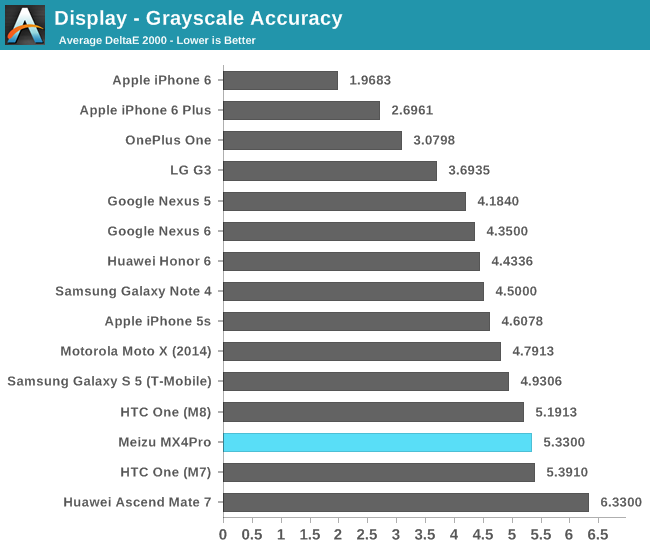
The grayscale accuracy lands at a deltaE2000 of 5.33, which represents a figure above the generally noticeable threshold of 3. The JDI screen seems to be calibrated for a cool color temperature target of 7400K, making the screen have a blueish tint on whites. There is unfortunately no setting to change the configuration of the screen.
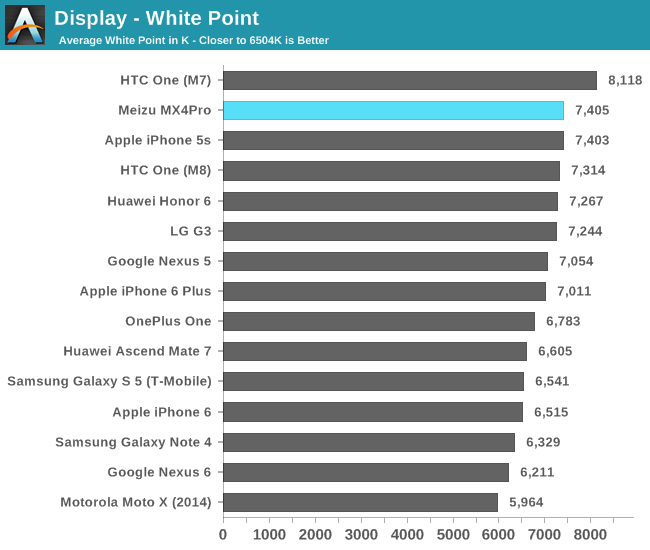

It's on the saturation accuracy where the Meizu sadly disappoints. The hue is off in the yellow and magenta spectrum, and all saturations beyond 80% suffer from significant compression. Colors are much too bright and have the radioactive look that people are familiar with on Samsung's AdobeRGB colorspace screen modes.

Due to the strong saturation compression and cold color temperature, the Gretag Macbeth color accuracy chart and deltaE2000 achieve only a disappointing figure of 4.98. This is considerably worse than other competing devices, with only the One M8 and Motorola's uncalibrated AMOLED devices performing worse.
Although the MX4 Pro impressed with its brightness, excellent sharpness, and outstanding low-light performance, it simply cannot be advised for people who appreciate color accuracy. For people who are looking for a "vibrant" and otherwise excellent display in all other aspects besides accuracy, I'm sure the Meizu MX4 Pro will more than satisfy.
Display Power
The detailed display power curve of the Note 4's AMOLED screen is something I want to translate to LCD screens too whenever I have the opportunity. The MX4 Pro's screen luminance rises exponentially to the actual brightness level of the backlight, which does have a noticeable effect on battery life tests that rely on standardized percentages rather than standard luminance.
The device power goes from from about 530mW at minimal brightness, up to 1.69W at the maximum 597 nits. Power seems to scale linearly with the luminance, meaning there should be no efficiency penalty of running the higher brightness levels. LCD screens remain the most efficient technology for high brightness mobile displays, as the break-even point for current generation AMOLEDs looks to lie at around 65% APL when displaying white content.
I couldn't measure any power difference when measuring various APL levels on the MX4 Pro, meaning that the power to drive the LCD matrix itself is negligible. It is to be mentioned that due to this being a QHD display, it suffers from the same MIPI-DSI bandwidth limitations as other 1440p smartphones, meaning the physical bandwidth of the D-PHY interface between the SoC's display controller and the display driver IC is not enough to drive the full resolution at 60fps. The Meizu MX4 Pro, much like other Exynos SoCs and the Galaxy Note 4 Exynos, is able to circumvent this limitation with help of MIC (Mobile Image Compression), enabling the phone to make due with just 4 MIPI DSI lanes and thus allowing for better power consumption in dynamic content, on top of what PSR (Panel Self Refresh) offers for static content.
With a good idea of what the screen's power and luminance characteristics are, let's continue on to the battery life tests of the MX4 Pro.


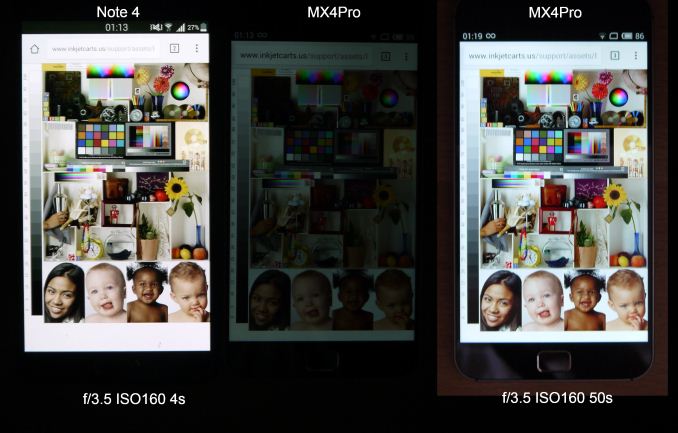
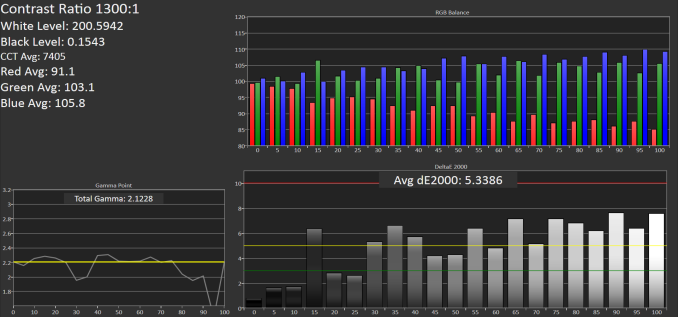
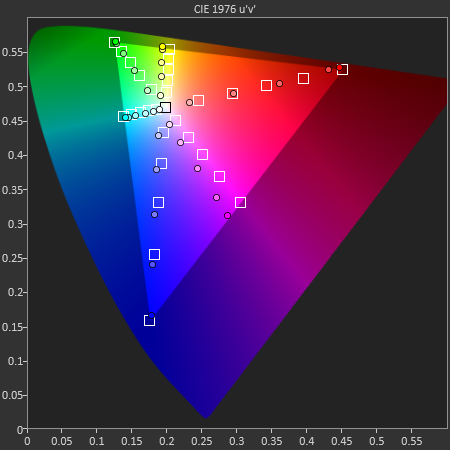

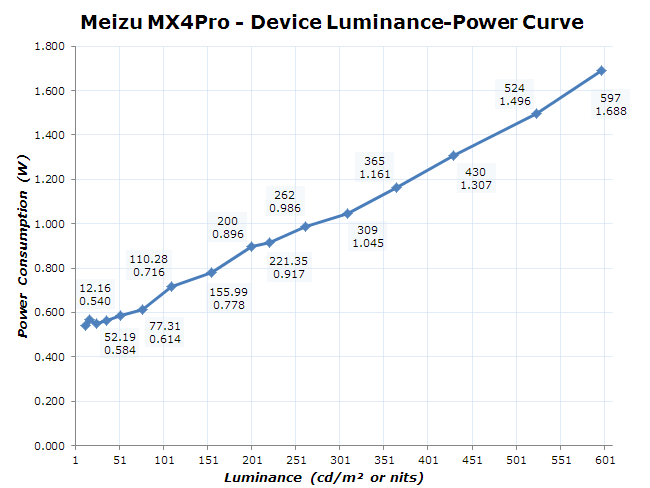








70 Comments
View All Comments
velanapontinha - Tuesday, May 26, 2015 - link
Hi, Andrew.Any ETA on the review of the "regular" MX4? MWC is long over.
AnandTech still doesn't have one single review to a Mediatek based device. Mediatek is no longer a Cyrix kind of thing, you guys should give it the spotlight it is starting to deserve.
pjcamp - Monday, February 16, 2015 - link
I'm baffled at how you guys can find time to review these obscure Chinese knock-off phones, but apparently can't manage to review a Sony.techcrazy - Monday, February 16, 2015 - link
It's Sony's fault. Andrei asked for a review unit but it looks like they didn't provide any review unit.http://www.anandtech.com/show/8655/the-huawei-asce... . Look at the comment section.
sonny73n - Wednesday, February 18, 2015 - link
Sony would never dare to let an unbiased tech site like AT to review their devices. Sony devices may look nice but if you take in depth approach into them, you'll surely be disappointed. Take a few flagships Sony has released just a couple of years back for examples - the ZR, ZL and Z1, all were made with TFT panels. And the recent Z3C isn't so good either - with so many reports of self-cracked front and back glass. Need I say more?notposting - Monday, February 16, 2015 - link
Regarding the plastic insets on the metal band -- aren't those generally used to separate discrete external antenna bands (like the iPhone 4 and so on)?xaueious - Monday, February 16, 2015 - link
The review is not really useful without reviewing the Marvell basebandSubmano - Monday, February 16, 2015 - link
Great review as the one with the Note 4 Exynos! On a side note, are you Andrei Lux from XDA? Cheerscjs150 - Monday, February 16, 2015 - link
I think I can answer the question why phone makers omit the microSD (and tablet makers).It is so they can rip the customer off by massively overcharging for additional memory. A 64Gb MicroSD card costs c. £25 whereas upgrading Nexus 6 from 32Gb to 64Gb costs £90 (Iphone 6 16G to 64G is an extra £80), tablets are the same.
PC Perv - Monday, February 16, 2015 - link
I really appreciate the power consumption section. I totally agree with you that we need some legitimate methodology for batter performance under mobile data (esp. LTE) Literally everyone experiences different battery performance using same devices because of different signal quality.I think it would be very helpful if you explain in a separate article as to when/how/why battery drains using mobile data? Are their differences between carriers? Or is it spectrum-bound? How much signal strength matter? Etc.
I also appreciate that you went a length to experiment with the power saving modes. A lot of people seem to use power saving mode without knowing what it does, hoping their devices last longer. Not only you gave us explanation on this phone's implementation but you also measured the efficiency of it - It is something I want to know in many phone reviews but reviews never explored it. I cannot thank you enough.
Keep up the good work!
croc - Monday, February 16, 2015 - link
Lesseeee... Known taps into every comms link going through the USA, and you are wondering if a China-made device has a backdoor? You have a strange set of priorities, my friend...